#Fraser Ronald
Text

Dan Duryea, Hardy Kruger, Peter Finch, Ernest Borgnine, Christian Marquand, George Kennedy, Ronald Fraser, and Ian Bannen rehearsing in a mockup of the plane cabin on the set of The Flight Of The Phoenix (1965)

#george kennedy#dan duryea#hardy kruger#ernest borgnine#peter finch#christian marquand#ronald fraser#ian bannen#the flight of the phoenix#1965#hollywood#old hollywood#classic movies#old movies#60s movies#aviation movies#disaster movies#on the set
20 notes
·
View notes
Text
In 1945 World War II had kept front line nurse Claire Randall and soldier husband Frank apart. Now that the war was concluded, the two embarked on a second honeymoon. Not only did Frank hope to reconnect with his wife, but looked to reconnect with his family’s past so chose to visit his ancestral home. Things seemed to be going well until Claire suddenly found herself hurled back to the year 1743 where she met one of Frank’s ancestors. ("Sassenach", Outlander, TV)

#nerds yearbook#sci fi tv#1945#ww ii#ww2#world war ii#world war 2#outlander#time travel#1743#scotland#caitriona balfe#claire fraser#diana gabaldon#ronald d moore#john dahl#sam heughan#jamie fraser#tobias menzies#frank randall#graham mctavish#dougal mackenzie#duncan lacroix#murtagh fraser#grant o'rourke#stephen walters#james fleet#tracey wilkinson#kathryn howden#prentis hancock
19 notes
·
View notes
Photo

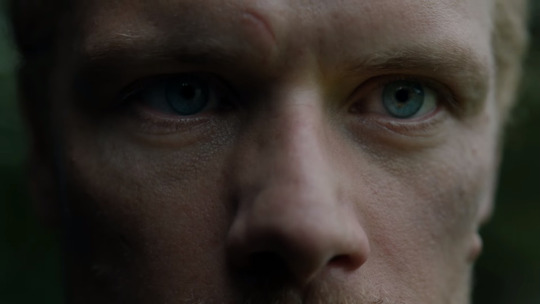
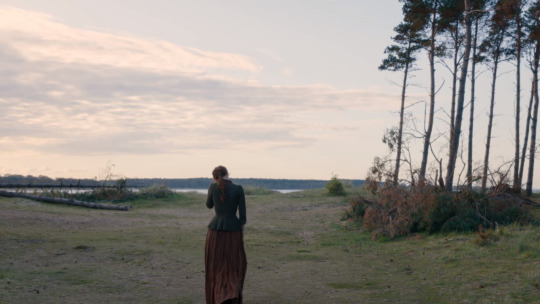


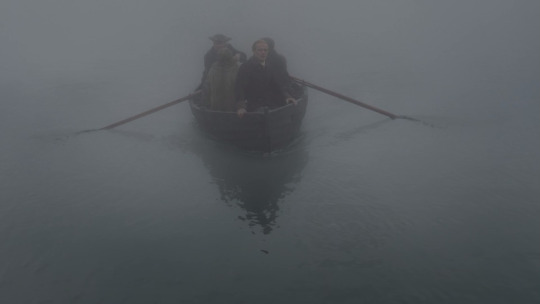
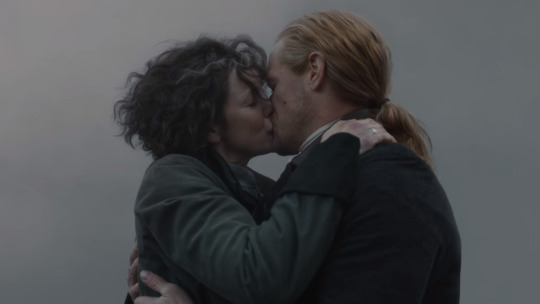
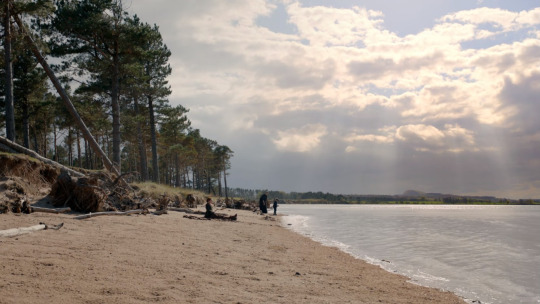

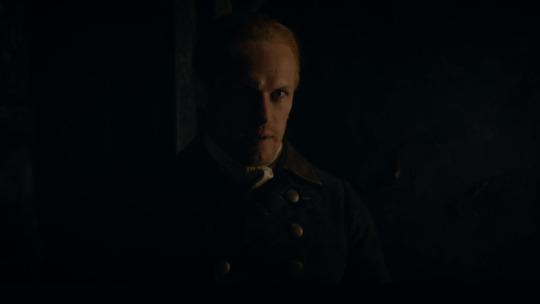
**Shots of the Episode**
Outlander (2014)
Season 7, Episode 1: “A Life Well Lost” (2023)
Director: Lisa Clarke
Cinematographer: Alasdair Walker
#shots of the episode#outlander#outlander series#starz#outlander starz#outlander season 7#outlander s7#outlander spoilers#2023#diana gabaldon#ronald d. moore#lisa clarke#alasdair walker#sam heughan#catriona balfe#sophie skelton#mark lewis jones#jamie fraser#claire randall#claire x jamie#jamie x claire#romance#period romance#a life well lost#cinematography#2023 tv#screencaps#screenshots#stills
38 notes
·
View notes
Text
Cage the Devil Series
Title: The Devil Wears a Suit and Tie
Summary: The Sheriff’s rival takes an interest in you and tries to recruit you.

Warnings: this is for 18+ minors DNI; stalking; abduction; alcohol and tobacco consumption; mentions of being hungover; mild cursing; this part is pretty mild compared to the other ones. I believe I have all of the warnings listed and I apologize if I miss anything but you are responsible for what you read.
A/N: This part is a little shorter than the others but it’ll pick back up in the next part! Lee isn’t featured in this part quite as much but don’t worry, I promise he’ll be in the next one a little more! Just needed a small part to introduce Lee’s rival! Also the gold glitter divider is by @firefly-graphics
Wordcount: 2,304
The half burned cigar glowed red at the tip, the embers crackled as Curt Goynes took another hit off of it. He let the smoke fill his lungs and nostrils as he continued to watch the Tecumseh Bar with his partner in crime, Ronald Russo. Curt blew the smirk from his nose and mouth as he waited for his target, you. You and some friend of yours went into the bar about two hours ago, that’s how long he and Russo had been sitting in this damn car for, if not longer. Curt adjusted in his seat as he thought about how peculiar this whole case was, he was very skeptical. He thought back to how adamant Jones was, there was something more to all of this, he had a gut feeling about it.
“You sure boss?” Curt flipped through the file and saw various information about you and your family.
Jones stopped what he was doing and looked up at the two men in front of him, he placed his hands on top of one another. He narrowed his eyes at Curt. “Are you questioning me, Goynes? All you need to know is your next target and not to fucking question me about it. Do I make myself clear?”
Curt and Ronald side eyed each other, both very incredulous of the whole situation. They nodded their heads in understanding and walked out of the office.
And that’s how they ended up here, they had been following you all day. Ronald flicked his wrist to look at his watch to check the time, it was past midnight and there had been no signs of you since you entered the bar. Ronald let out a disgruntled sigh which caused Curt to look over at him and he offered him the cigar. Ronald glanced down at the half-smoked cigar before he accepted it and took a long drag. He inhaled the smoke for a moment, letting it burn his lungs before he let it all out through his mouth and nose. He handed the cigar back to his partner as he shook his head.
“This is all a waste of time if you ask me.”
Curt took another hit off of the cigar before he looked over at his partner briefly, letting out the smoke from the cigar. “Yeah, I feel the same way but a job’s a job, gotta get it done.”
A few more hours passed as Curt and Ronald staked out the bar. They were just about to give up when they noticed that you were exiting the bar. Their interest piqued even more when they realized who you were with, none other than the Sheriff himself. The pair looked at each other, this is what they had been waiting for all night. Ronald quickly got his old camera back out and snapped a few pictures.
“Jones is gonna eat this shit up.” Curt commented as he took one last hit on the cigar.
“Yeah he is. Come on, let’s get the hell out of here.” Ronald snapped one more picture just as he saw the Sheriff getting into his car with you already in it.
Curt didn’t need to be told twice as he put down the cigar into the ashtray before he started the car. He pulled out the empty lot they had been parked in and drove off. The next morning, Curt and Ronald walked into their boss’s office with the pictures in hand. Curt stepped back as Ronald threw down the pictures onto Jones’s desk. Jones stopped what he was doing as he looked up at the two men. He didn’t say a word as he started to look through the pictures, an evil grin formed on his lips, pleased at what the two men had brought him.
“Excellent. I want you to bring her to me, discreetly of course. And alive please.”
Curt and Ronald side eyed each other before Ronald spoke up, his curiosity getting the better of him. “Boss, what’s this all about?”
Jones let out a frustrated sigh as he put his pen down before looking back up at his goons. “Let’s just say, there’s some unfinished business between her family and I.”
Curt and Ronald don’t say anything, they know that this is just business but to them, you seem completely innocent. Well, for the most part anyway. When Jones slammed his hand on his desk, it shocked the pair of them.
“Grow a pair of fucking balls! God dammit! Don’t make me bring someone else in to do this job!”
Both men spoke up at the same time. “Right!” “On it boss!” They then scurried out of the office.

For you, it had been like any other day. You worked your shift at the diner, surprisingly only slightly hung over. Thankfully Darcy didn’t give you too much trouble for bailing on them, in fact, it was quite the opposite. She was more curious about it than anything, wanting to know every little, sinful detail. You did your best to brush off any of her questions, you were sure Lee wouldn’t want you blabbing to your friends how you sucked him off in the parking lot. However, when Lee and some of his deputies came in for an early dinner, you had a hard time keeping your eyes off of him. Darcy quickly figured it out and you had to pull her off to the side.
“You can’t say anything!” I whisper-yelled at her as I pointed my index finger at her.
“Alright, fine, I won’t. But don’t tell me you’re gonna let Miss Prim take care of your man.” Darcy whispered back with a raised eyebrow.
You were about to reply when a customer interrupted. “Miss, some coffee please.”
“Yeah, yeah, yeah, just a second granny.” Darcy snapped back and you had to hold back a laugh with how taken aback the older lady looked.
“I wouldn’t call him my man-”
“But you want him to be.” She smirked as she watched you glance over your shoulder to look at Lee.
“Miss, coffee!” The old lady interrupted again.
Before either of you could say anything, it was Ari who had interrupted. “Girls, get back to work!”
You and Darcy quickly got back to work and finally refilled the old lady’s coffee. Throughout your shift, you stole glances over at Lee and you cringed when you noticed Penny trying to flirt with him and the other deputies. You wanted nothing more than to go over there to show he wasn’t available but one night in his car does not make a relationship. Maybe the start of one or maybe that was it, just one night. You sighed as you got back to wiping a table to make it clean for the next customer. You were almost thankful when they left so you no longer had to witness Penny throw herself at Lee and the other deputies. When your shift was over, you couldn’t have been more grateful. Your feet hurt and you were beyond exhausted. You were walking down the block to your car when you started to feel as though you were being followed.
Cautiously, you glanced over your shoulder and noticed a man a few feet behind you. He was wearing a long, tan trench coat with his hand tucked into his pockets. He was wearing a navy blue Homburg hat on top of his thick, brown hair. He stopped walking and turned his attention towards the store window and began to whistle. You thought his behavior was odd which caused you to walk quicker to your car. Before you could reach your car though, another man appeared out of nowhere and grabbed you. His rough hand covered your mouth before you had a chance to scream. YOu did your best to fight off the two men but they easily overpowered you and dragged you to a waiting car that was in the alley.
When you finally came to, you were laying on a couch and there was a song softly playing on the radio. You groaned as you sat up and pressed a hand to your forehead. You looked around the room and it looked to be some sort of study or office.
“....Don’t you know the devil wears a suit and tie…. Saw him driving down the 61 in early July…. White as a cotton field and sharp as a knife…. I heard him howling as he passed me by…. And he said….”
You were just about to get and explore the room that you were trapped in, when the door suddenly opened. You snapped your head in that direction and saw three men standing in the doorway. One of them, you recognized as the man who had been following you but you had no clue who the other two were. Your instincts were in fight or flight mode and you wanted to run but there was nowhere to run too. You study the other two men as the music continues to play, it’s almost as if you’re standing off with them.
“....I know you, I know you young man…. I know you by the state of your hands…. You’re a six-string picker…. Just as I, I am…. Let me learn you something…. I know a few turns to make all the girls dance….”
The other man had dark brown skin and was wearing a charcoal gray suit with a white undershirt and a thick red and gold striped tie. His fedora matched his suit but it had a thick piece of red satin wrapped around the base. He and his partner both had masks on but they only covered the top part of their faces and it was a thin piece of white rubber. They looked quite ridiculous honestly. The masks had holes cut out for the eyes and ears which is how they were being held up. Your attention then turned to the man in front of them.
“....Don’t you know the devil wears a suit and tie…. I saw him driving down the 61 in early July…. White as a cotton field and sharp as a knife…. I heard him howling as he passed me by….”
He was tall and a heavily built man with thinning brown hair. He looked well put together as he wore a proper three-piece black suit along with nice black dress shoes. A shiver crawled down your spine as you looked at him, you could tell by just looking into his eyes that he was not a good man. He stood there poised and with his hands neatly placed in front of him. The way he smiled knowingly at you caused goosebumps to form all over. You wanted to know what the hell was going on but you didn’t want to be the first to speak up, the only thing that filled the tense silence was the music.
“....Oh, foolish, foolish, was I…. Damn my foolish eyes….”
“Someone turn that shit off,” The man in front barked, he then adjusted his tie as he collected himself as one of your abductors went and shut off the radio. “My apologies, you must be wondering why you’re here.”
You watched as he walked over to the chair across from you and took a seat. He crossed his legs and stared at you, his eyes held so much intensity that it tied your stomach into knots. You were thankful when he was the first one to look away and snapped at his men, looking at them as he did.
“You can leave now.”
Without another word, the two men left the room, closing the door behind them. You watched them leave and turned your attention back to the man sitting across from you when he cleared his throat. His legs were crossed and he rested his arms on top of the arm rests. The two of you continued to stare at each other and the tension was so thick in the room, you could cut it with a knife.
“I bet you’re wondering why you’re here, hmm?” His deep voice only thickened then tension.
You scrunched up your face for a moment before you spoke up. “Who the hell are you?”
“Right, forgive me, where are my manners? I'm Doug Jones.” His grin was devilish as he introduced himself. He spoke up as he leaned forward, folding his hands out in front of him. “Don’t worry darlin’, I know who you are.”
A shiver runs through your body the way he says your name. You take a deep breath before you speak up. “Whatever it is you want, I’m not interested.”
You leaned back against the couch and crossed your arms over your chest, your stubbornness showing through. It probably wasn’t wise to be a brat with such a devil of a man like Doug Jones but you weren’t about to cave to whatever his sick desires he wanted. He started to click his tongue in disapproval before he got up from his chair and he walked over to the drink cart. You watched as he poured himself a drink and you declined when he started to offer you one. He took a quick drink from his glass and swallowed some of the amber colored liquid.
“Hmm, not quite as good as the stuff Bodecker has but it’ll do.” He took another drink before he went to sit back down, he crossed his legs as he did.
You felt your stomach drop at the mention of Lee’s name. You had an inkling about what this was about and you didn’t like it.
“Ah, I see you’re a smart one. I can see the gears turning in your eyes. I have a proposition for you and I hope you’re smart enough to make the right decision.”
#cage the devil series#cage the devil au#the devil all the time au#lee bodecker#sheriff lee bodecker#no sudden move au#no sudden move#doug jones#curt goynes#ronald russo#brendan fraser characters#sebastian stan characters#brendan fraser#sebastian stan#sheriff bodecker x reader#lee bodecker x reader#multi fandom au#chris evans characters#marvel characters
31 notes
·
View notes
Text


Original album cover for 'Beggars Banquet', rejected by Decca. The title of the album as well as all the credits, are hidden under the graffiti, such as: "Peter is a faggot"; "Lyndon (B. Johnson, U.S. President) loves Mao"; "God rolls his own"; "Maharishi were here"; "Ronald Reagan is a sissy"; "Rent-a-cop"; "Strawberry Bob (Robert Fraser) for President"; "Bob Dylans dream"; and just to the left over the sewer pipe is "Spanish Tony where are you?", a supposed distress call from long-time drug addict Keith Richards.
#photo by Barry Feinstein#source: Willi Winkler#the rolling stones#keith richards#lyndon b. johnson#mao tse tung#maharishi mahesh yogi#the beatles#ronald reagan#Robert Fraser#bob dylan#spanish tony#barry feinstein#decca records#beggars banquet#sixties#60s rock#60s music#60s#rock band#old rockstar#classic rock#tony sanchez
6 notes
·
View notes
Photo

#the flight of the phoenix#james stewart#richard attenborough#peter finch#hardy kruger#ernest borgnine#ian bannen#ronald fraser#christian marquand#dan duryea#george kennedy#alex montoya#barrie chase#robert aldrich#1965
3 notes
·
View notes
Text
Like Fisher, whose disciple he became, Roberts was a political and religious conservative – raised a Methodist, he developed strong Roman Catholic inclinations and compromised on the Church of England – and he inclined to a reform eugenics compatible with his scientific knowledge and social temperament.
"In the Name of Eugenics: Genetics and the Uses of Human Heredity" - Daniel J. Kevles
#book quote#in the name of eugenics#daniel j kevles#nonfiction#ronald fisher#john fraser roberts#disciple#conservative politics#religious conservative#methodist#roman catholic#catholic#church of england#anglican#eugenics#scientific knowledge#temperament
0 notes
Text
THE FLIGHT OF THE PHOENIX (1965):
Plane crash in desert
Men going mad from the heat
Make new plane from scraps
youtube
#the flight of the Phoenix#random richards#poem#haiku#poetry#haiku poem#poets on tumblr#haiku poetry#haiku form#criterion collection#james stewart#richard attenborough#peter finch#hardy kruger#ernest borgnine#Ian bannen#Ronald Fraser#Christian Marquand#dan duryea#george kennedy#gabriele tinti#barrie chase#robert aldrich#Lukas heller#Trevor Dudley Smith#elleston trevor#Youtube
1 note
·
View note
Text
'Outlander' renovada para octava y última temporada, Starz da luz verde oficialmente a la serie de precuelas....

View On WordPress
#Caitlin O&039;Ryan#Caitríona Balfe#Charles Vandervaart#David Berry#Diana Gabaldon#Izzy Meikle-Small#Jamie Fraser#John Bell#Outlander#Outlander: Blood of My Blood#Paul Gorman#Richard Rankin#RONALD D. MOORE#Sam Heughan#Series#SONY PICTURES TELEVISION#Sophie Skelton#STARZ
0 notes
Photo
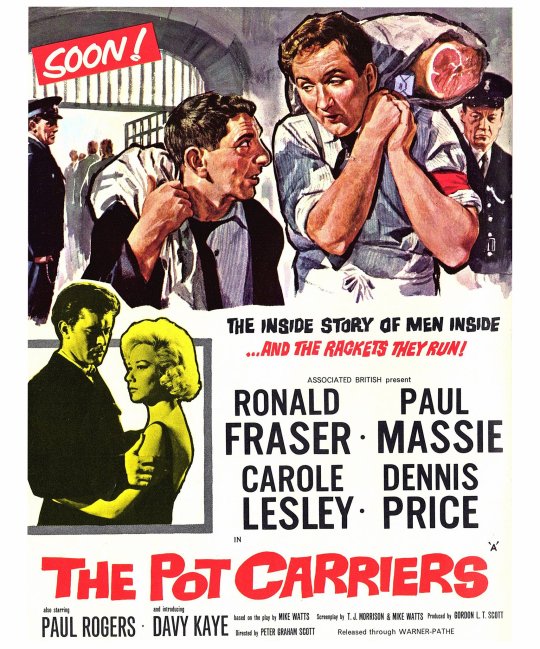



The Pot Carriers (1962) Peter Graham Scott
January 2nd 2022
#the pot carriers#1962#peter graham scott#ronald fraser#paul massie#davy kaye#carole lesley#dennis price#paul rogers#eddie byrne#alfred burke#vanda godsell
1 note
·
View note
Text


Instagram
•••••
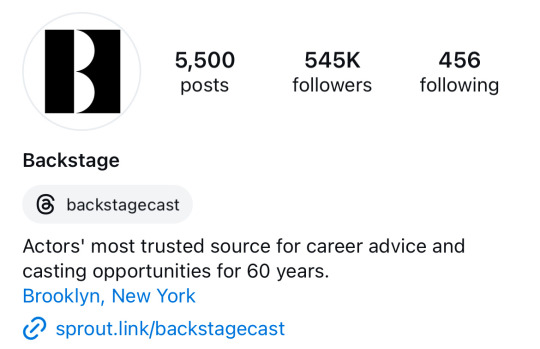
•••••
WHAT THE STARS ARE SAYING
Check out why so many famed actors use Backstage
Trusted since 1960
Founded in 1960, Backstage has a storied history of serving the entertainment industry. For over 60 years Backstage has served as a casting resource and news source for actors, performers, directors, producers, agents, and casting directors.
Over that time, Backstage Magazine has also appeared on numerous TV shows, such as “Mad Men,” “Entourage,” “Glee,” “Oprah,” NBC's “Today” show, Comedy Central's “@Midnight”, NY1's “On Stage,” and “Saturday Night Live,” as well as multiple mentions on shows like “Inside the Actor’s Studio,” “Girls,” and appearances in films such as “13 Going on 30,” the Farrelly brothers' “Stuck on You” and Spike Lee's “Girl 6,” and even a mention in Woody Allen's short-story collection “Mere Anarchy” and Augusten Burroughs' novel “Sellevision” – and Backstage has received accolades from multiple Academy Award-, Emmy-, and Tony-winning actors and directors. (Plus, the hit musical “The Last Five Years” even includes Backstage in its lyrics: “Here's a headshot guy and a new Backstage / Where you're right for something on every page.”)
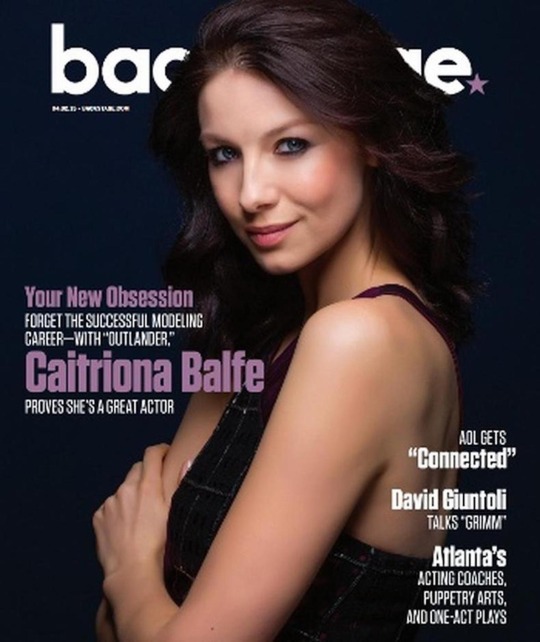
CAITRÍONA BALFE
ACTRESS
"I still get Backstage emails 'cause I still subscribe to Backstage. [Backstage is) kind of the Bible in the beginning, which is amazing. Samuel French and Backstage go hand in hand, you know? You go there for your plays when you're in classes, and then you get your Backstage."
Backstage 1
•••••
Brian’s Note: The following story originally appeared in April 2015. Most recent update is December 2020.
The Gorgeous Determination of Caitríona Balfe
Caitríona Balfe is on the move. That's been true most of her adult life— especially the 10 years she was modeling for Victoria's Secret, Dolce & Gabbana, and others—but as she sits on the rooftop patio of a West Hollywood hotel in mid-March, she mentions that she's pulling up stakes from Los Angeles.
"It just feels silly to have an empty place for 10 months until I figure out what I'm doing with my life," the Irish-born actor says. "I've rented the same place for the last four years and now I have to give it up." Her apartment is being razed to put in condos, but her departure from L.A. is extra poignant considering this is the city where Balfe journeyed when she decided to put aside that successful modeling career and focus on the vocation she'd always wanted: acting.

Photo: Luc-Richard Elie
"I've moved so much since I was 18," she says. "I mean, l've lived so many places. New York, I lived in for almost eight years [while modeling], and that's been the longest of anywhere since I left Ireland. But L.A. is where I came and said, 'OK, this is what I wanna do with my life.' "
She refuses to think of her move as a permanent one, though. "I'll be back," she declares, "but it feels really sad. My little apartment, it's got so many memories."
Balfe's sadness is no doubt mitigated by the fact that part of her need to move is due to the precipitous rise in her fortunes. She'll soon be flying to Scotland to shoot the second season of "Outlander," which returns to Starz April 4 to conclude Season 1.
When last we saw Balfe's Claire, the resourceful British nurse who comes home after World War |I only to be inexplicably teleported into the 18th-century Highlands, she was half-naked with a knife to her breast. Don't worry: Claire will get out of that scrape, but more perils await-to say nothing of the emerging multi-era romantic triangle developing between her, the Scottish warrior Jamie Fraser (Sam Heughan), and her 20th-century husband, Frank Randall (Tobias Menzies), who wonders where she's gone.
Based on the much-beloved Diana Gabaldon novels and developed for television by "Battlestar Galactica" rebooter Ronald D. Moore, "Outlander" is an ostensibly lush period-piece-within-a-period-piece drama that's consistently richer and thornier than its romance-novel trappings suggest. And much of the credit goes to Balfe, who had managed small parts in films such as “Super 8” and “Now You See Me” before landing the central role in this adaptation.
In person, Balfe is far less imposing than the steely Claire, who has to weather the dangers of being a woman in sexist, violent Scotland in the 1740s. Cast late in the preproduction of “Outlander”—Moore has mentioned in interviews how hard it was to find the right Claire—she didn’t have time to consider what the role would do to her life. “I’m so bad on social media," she confesses on this warm afternoon, nestled underneath a cabana. "I had set up an account on Twitter maybe a year or so before I got this job and had, I thought, a lot of followers — 250 or something, and most of them are my friends. Within about a month or two, it was thousands of people — and my phone, I didn't know how to turn off the alerts, so it was just going all the time. That was the beginning of the awareness."
Growing up in the small Irish community of Monaghan, Balfe had considered acting from an early age. ("I was devastated that I wasn't a child actor," she says, smiling. But after traveling to Dublin to study theater, she changed course once she received an offer to model. It wasn't a secret passion of hers, but who turns down a trip to Paris? "My parents felt that I should finish college," Balfe recalls, "but l'm slightly headstrong, so l took their advice and I completely ignored it."

Over the next decade, she lived in France, Italy, Germany, and Japan, her modeling inexperience hardly a detriment. "You'd be amazed how little information or training goes into it," she says. "When I first arrived in Paris, I was told to take a bus to the office. I left my suitcase — I barely spoke any French — and someone took me across the street, helped me buy a Carte Orange. They printed out five addresses that I had to go to that day, and then they sent me off." She still remembers at 18 riding the subway alongside 16-year-old aspiring Russian models, who knew no French or English, homesick and sobbing their eyes out. "That was just the way it was," says Balfe. "You become pretty tough. When I went to Japan, it was similar: They would drive you to their castings, but the minute you got a job, it would be like, 'Here's an address, here's a map. Good luck.' They don't have signposts in English in Japan, so the map and the address are not always very helpful."
Hear Balfe recount her early misadventures in modeling and you can't help but think of Claire, who's equally thrown to the wolves once she arrives in the 18th century amid people wary of the English in general and assertive women in particular. "Honestly, l've been in so many situations in my life where you just are completely displaced," Balfe says. “You have to adapt very quickly and figure it out. I definitely think that informs Claire a lot. It helped me understand her."
Did moving to Paris at such a young age teach Balfe that she can cope in any circumstance? "I think I didn't really realize that until many years later," she replies. "I have a great knack of not thinking about things and just going for it. You learn the hard way sometimes that you're able to get through, but sometimes it's quite tough when you're in a situation where you don't know anyone and you're trying to find your way around cities. But if an opportunity presents itself and it seems like a good idea, l'm just like, 'OK, let's do it, then I'll figure it out.'”
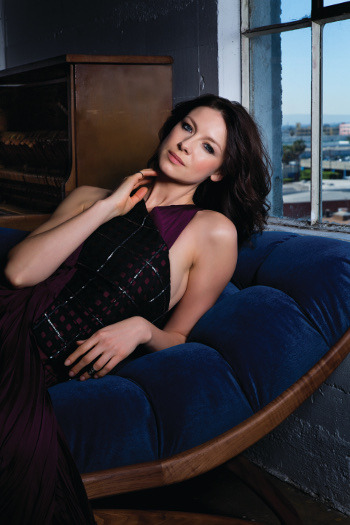
The decision to reconnect with her acting ambitions was conducted just as boldly. Ready to quit modeling, she moved to Los Angeles because a writer she was dating lived there. He was the only person she knew, but she had read a Vanity Fair interview with Amy Adams in which she said she trained with Warner Loughlin. "I could walk to that place from my ex-boyfriend's house," she says, "so l was like, 'Well, I'm gonna go there because I can't really drive. I started from scratch. I didn't have any managers, I didn't know any agents, I hadn't acted in almost a decade." But she just kept taking classes, moving from Loughlin to the studios of Sanford Meisner and Judith Weston. "I think when I first got here, I had a nice little air of delusion: 'It's gonna work out,'" she says with a laugh. “You just don't know how."
And then came "Outlander." By email, Moore admits that he didn't know Balfe's work until her audition tape came unsolicited to his office from her agent. Once she was chosen for Claire, he made it clear how demanding the job would be. “I told her in our first meeting that this was going to be an even bigger responsibility and workload than the normal TV lead," he writes. "Because the story was being told from Claire's point of view, Cait was going to be in every scene, every day for months, which is an extraordinary amount of work, far beyond what most actors are ever asked to do."
Moore's warning didn't faze Balfe. Writes Moore, "After she met with the president of Starz... and it was clear that she was going to land the role, I walked her to the elevator and just before the doors closed on her, I said 'Your life is about to change forever,' and she gave me a grin that was both thrilled and slightly nervous. I never saw her hesitate after that."
She's never hesitated before. As Balfe prepares to say goodbye to L.A. (for now, she thinks back to her early days in the city, trying to convince casting directors that she was more than just a model. "I went on many, many, many, many auditions that were Hot Girl No. 2 — you wanna shoot yourself," she says, laughing. "But, you know, I'm very lucky that l was even getting those auditions in the beginning. And it toughens you up. At least for me, to have that fuel to prove people wrong—it definitely spurs me on and makes me wanna work harder." Then she smiles conspiratorially. "And shove it to them."
Backstage 2
Remember… I told her in our first meeting that this was going to be an even bigger responsibility and workload than the normal TV lead. — Ronald D Moore
#Tait rhymes with hat#Good times#National Actors Day#8 September 2024#Backstage#April 2015#Story last updated December 2020#Instagram
35 notes
·
View notes
Text

I.8.1 Is the Spanish Revolution inapplicable as a model for modern societies?
Quite the reverse. More urban workers took part in the revolution than in the countryside. So while it is true that collectivisation was extensive in rural areas, the revolution also made its mark in urban areas and in industry.
In total, the “regions most affected” by collectivisation “were Catalonia and Aragón, where about 70 per cent of the workforce was involved. The total for the whole of Republican territory was nearly 800,000 on the land and a little more than a million in industry. In Barcelona workers’ committees took over all the services, the oil monopoly, the shipping companies, heavy engineering firms such as Volcano, the Ford motor company, chemical companies, the textile industry and a host of smaller enterprises … Services such as water, gas and electricity were working under new management within hours of the storming of the Atarazanas barracks … a conversion of appropriate factories to war production meant that metallurgical concerns had started to produce armed cars by 22 July … The industrial workers of Catalonia were the most skilled in Spain … One of the most impressive feats of those early days was the resurrection of the public transport system at a time when the streets were still littered and barricaded.” Five days after the fighting had stopped, 700 tramcars rather than the usual 600, all painted in the black-and-red colours of the CNT-FAI, were operating in Barcelona. [Antony Beevor, The Spanish Civil War, pp. 91–2]
About 75% of Spanish industry was concentrated in Catalonia, the stronghold of the anarchist labour movement, and widespread collectivisation of factories took place there. As Sam Dolgoff rightly observed, this “refutes decisively the allegation that anarchist organisational principles are not applicable to industrial areas, and if at all, only in primitive agrarian societies or in isolated experimental communities.” [The Anarchist Collectives, pp. 7–8] According to Augustin Souchy:
“It is no simple matter to collectivise and place on firm foundations an industry employing almost a quarter of a million textile workers in scores of factories scattered in numerous cities. But the Barcelona syndicalist textile union accomplished this feat in a short time. It was a tremendously significant experiment. The dictatorship of the bosses was toppled, and wages, working conditions and production were determined by the workers and their elected delegates. All functionaries had to carry out the instructions of the membership and report back directly to the men on the job and union meetings. The collectivisation of the textile industry shatters once and for all the legend that the workers are incapable of administrating a great and complex corporation.” [Op. Cit., p. 94]
Moreover, Spain in the 1930s was not a backward, peasant country, as is sometimes supposed. Between 1910 and 1930, the industrial working class more than doubled to over 2,500,000. This represented just over 26% of the working population (compared to 16% twenty years previously). In 1930, only 45% of the working population were engaged in agriculture. [Ronald Fraser, The Blood of Spain, p. 38] In Catalonia alone, 200,000 workers were employed in the textile industry and 70,000 in metal-working and machinery manufacturing. This was very different than the situation in Russia at the end of World War I, where the urban working class made up only 10% of the population.
Capitalist social relations had also penetrated the rural economy by the 1930s with agriculture oriented to the world market and approximately 90% of farm land in the hands of the bourgeoisie. [Fraser, Op. Cit., p. 37] So by 1936 agriculture was predominately capitalist, with Spanish agribusiness employing large numbers of labourers who either did not own enough land to support themselves or where landless. The labour movement in the Spanish countryside in the 1930s was precisely based on this large population of rural wage-earners (the socialist UGT land workers union had 451,000 members in 1933, 40% of its total membership, for example). In Russia at the time of the revolution of 1917, agriculture mostly consisted of small farms on which peasant families worked mainly for their own subsistence, bartering or selling their surplus.
Therefore the Spanish Revolution cannot be dismissed as a product a of pre-industrial society. The urban collectivisations occurred predominately in the most heavily industrialised part of Spain and indicate that anarchist ideas are applicable to modern societies Indeed, comforting Marxist myths aside, the CNT organised most of the unionised urban working class and, internally, agricultural workers were a minority of its membership (by 1936, the CNT was making inroads in Madrid, previously a socialist stronghold while the UGT main area of growth in the 1930s was with, ironically, rural workers). The revolution in Spain was the work (mostly) of rural and urban wage labourers (joined with poor peasants) fighting a well developed capitalist system.
In summary, then, the anarchist revolution in Spain has many lessons for revolutionaries in developed capitalist countries and cannot be dismissed as a product of industrial backwardness. The main strength lay of the anarchist movement was in urban areas and, unsurprisingly, the social revolution took place in both the most heavily industrialised areas as well as on the land.
#anarchist society#practical#practical anarchism#practical anarchy#faq#anarchy faq#revolution#anarchism#daily posts#communism#anti capitalist#anti capitalism#late stage capitalism#organization#grassroots#grass roots#anarchists#libraries#leftism#social issues#economy#economics#climate change#climate crisis#climate#ecology#anarchy works#environmentalism#environment#solarpunk
10 notes
·
View notes
Text
"Thus many collectives did not compete with each other for profits, as surpluses were pooled and distributed on a wider basis than the individual collective.
This process went on in many different unions and collectives and, unsurprisingly, the forms of co-ordination agreed to lead to different forms of organisation in different areas and industries, as would be expected in a free society. However, the two most important forms can be termed syndicalisation and confederationalism (we will ignore the forms created by the collectivisation decree as these were not created by the workers themselves).
Syndicalisation (our term) meant that the CNT’s industrial union ran the whole industry. This solution was tried by the woodworkers’ union after extensive debate. One section of the union, “dominated by the FAI, maintained that anarchist self-management meant that the workers should set up and operate autonomous centres of production so as to avoid the threat of bureaucratisation.” However, those in favour of syndicalisation won the day and production was organised in the hands of the union, with administration posts and delegate meetings elected by the rank and file. However, the “major failure … (and which supported the original anarchist objection) was that the union became like a large firm” and its “structure grew increasingly rigid.” [Ronald Fraser, Blood of Spain, p. 222] According to one militant, “From the outside it began to look like an American or German trust” and the workers found it difficult to secure any changes and “felt they weren’t particularly involved in decision making.” [quoted by Fraser, Op. Cit., p. 222 and p. 223] However, this did not stop workers re-electing almost all posts at the first Annual General Assembly.
In the end, the major difference between the union-run industry and a capitalist firm organisationally appeared to be that workers could vote for (and recall) the industry management at relatively regular General Assembly meetings. While a vast improvement on capitalism, it is hardly the best example of participatory self-management in action.
(...)
The other important form of co-operation was what we will term confederalisation. This system was based on horizontal links between workplaces (via the CNT union) and allowed a maximum of self-management and mutual aid. This form of co-operation was practised by the Badalona textile industry (and had been defeated in the woodworkers’ union). It was based upon each workplace being run by its elected management, selling its own production, getting its own orders and receiving the proceeds. However, “everything each mill did was reported to the union which charted progress and kept statistics. If the union felt that a particular factory was not acting in the best interests of the collectivised industry as a whole, the enterprise was informed and asked to change course.”
This system ensured that the “dangers of the big ‘union trust’ as of the atomised collective were avoided.” [Fraser, Op. Cit., p. 229] According to one militant, the union “acted more as a socialist control of collectivised industry than as a direct hierarchised executive.” The federation of collectives created “the first social security system in Spain” (which included retirement pay, free medicines, sick and maternity pay) and a compensation fund was organised “to permit the economically weaker collectives to pay their workers, the amount each collective contributed being in direct proportion to the number of workers employed.” [quoted by Fraser, Op. Cit., p. 229]
As can be seen, the industrial collectives co-ordinated their activity in many ways, with varying degrees of success."
I.8.4 How were the Spanish industrial collectives co-ordinated?
6 notes
·
View notes
Text
BOMB! 💥


By Nicole Mitchell & Gordon Terris
Filming for the new Outlander prequel takes place in Glasgow 🏴 By Nicole Mitchell & Gordon Terris
Actors Jeremy Irvine and Hermione Colfield have been spotted in the city's Park Circus on the set of Outlander: Blood of my Blood.
The new series focuses on the lives and courtship of the parents of Jamie Fraser but will also tell the story of Claire Randall's parents which is set around the time of the First World War.
Jeremy will star as Henry Beauchamp, Claire's father, while Hermione plays Julia Moriston, Claire's mother.
Pictures from the set appear to show Jeremy dressed as a soldier while a horse and cart is pictured in the background.
Several extras have also been pictured on set.
Outlander showrunner Matthew B. Roberts will write and executive produce the new series, while Ronald D. Moore and Maril Davis will also return as executive producers.








Posted 5th March 2024
#BOMB #JeremyIrvine #HermioneColfield
12 notes
·
View notes
Text
“They went to live at Radnor and for a little while everything went well. Margaret had a nice house, and was gay and happy. She dressed beautiful and entertained a good deal. Then—well, Ronald Fraser’s first wife turned up looking for him! She wasn’t dead after all.
“Oh, there was terrible scandal, Master. The talk and gossip was something dreadful. Every one you met had a different story, and it was hard to get at the truth. Some said Ronald Fraser had known all the time that his wife wasn’t dead, and had deceived Margaret. But I don’t think he did. He swore he didn’t. They hadn’t been very happy together, it seems. Her mother made trouble between them. Then she went to visit her mother in Montreal, and died in the hospital there, so the word came to Ronald. Perhaps he believed it a little too readily, but that he DID believe it I never had a doubt. Her story was that it was another woman of the same name. When she found out Ronald thought her dead she and her mother agreed to let him think so. But when she heard he had got married again she thought she’d better let him know the truth.
I'M DYING like girlie at some point you have to commit to the 'faked your death' approach
#clearly the both of you wanted to get divorced#just let it be#kilmeny of the orchard#batrachised reads kilmeny#kilmeny readalong
14 notes
·
View notes
Text
Kilmeny will not marry Eric because she is mute, so Eric starts thinking about if there is a way to cure her muteness. He asks Janet Gordon if they have ever taken Kilmeny to a doctor. She says no, Margaret wouldn't hear of it. Thomas wanted to, when Kilmeny was young, but it was forbidden and everyone bowed to Margaret's every whim.
Margaret Gordon sounds like she terrorized the entire household, to be honest. Janet said a couple chapters ago that she did her best to shield her from sorrow, but I think perhaps the result was that Margaret was simultaneously smothered and spoiled and made it everyone's problem. No wonder Kilmeny is so good at reading shifting moods.
We then learn that there is more to the story of Margaret Gordon than Mrs. Williamson (hey, remember her? Been a hot minute since we heard about her, now that Janet has taken on the role of kindly elderly female dispenser of plot and wisdom. Her name is Elizabeth, by the way.) Anyway, there is more to the story than Mrs. Williamson knew. When Margaret came home after her marriage fell apart, her father was terribly angry. He hadn't wanted her to marry Ronald Fraser, but she did anyway. And her father "called her a hard name".
There's been some discussion about what that name was -- I saw suggestions of whore, harlot, and jezabel, all of which seem plausible. And Margaret refused to say a word in response to this, even after he realized he had been cruel and apologized and asked her forgiveness. And Margaret refused to speak another word to anyone from that moment until after Kilmeny was born. She also spent all her time sitting in her room staring at the wall.
So, you know, doing well!
When her father is dying, he begs her to come to him one last time. She refuses, and so he has Thomas and Janet bring him to her. He says he cannot go meet his dead wife (her mother) until their daughter has forgiven him for calling her such a dreadful name. He begs and pleads and prays and she refuses to speak a single word to him. Her stubbornness has become a curse, forcing her to stay silent even when -- as she tells Janet later -- she wanted to speak. But she did not. And he died, unforgiven.
Kilmeny was born soon after, and the love and magic of motherhood melted the curse and Margaret spoke again. But it was too late, she could never forgive her father now, and when she realized Kilmeny wasn't going to talk she went half mad thinking this divine retribution for her sin of silence. As Janet puts it, "Kilmeny can't speak because Margaret wouldn't."
So there's a lot to unpack here. Most obviously, this is the culmination of the whole 'Kilmeny has only ever existed as an extension of her mother' theme we've been working. It's also another example of the way that women are only ever supporting characters to the men in their lives -- Margaret's sin was specifically that she wouldn't forgive her father. That stubbornness then cursed her daughter.
But we move on swiftly from that to Eric's favorite activity: not taking no for an answer. He says they will send for David Baker anyway, and will have him examine Kilmeny and also tell him an edited version of the story so that he has all the facts. Janet agrees -- again, we aren't asking Kilmeny's permission here -- presumably because she's realized that arguing with Eric will only lead to more tedious arguing with Eric and that he, unlike you, has nothing better to do with his day than argue this point.
Eric does, at least, tell Kilmeny of his plan, and we end the chapter with the following exchange:
But a rosy glow of hope flashed over Kilmeny’s face when Eric told her what he meant to do.
“Oh, do you think he can make me speak?” she wrote eagerly.
“I don’t know, Kilmeny. I hope that he can, and I know he will do all that mortal skill can do. If he can remove your defect will you promise to marry me, dearest?”
She nodded. The grave little motion had the solemnity of a sacred promise.
“Yes,” she wrote, “when I can speak like other women I will marry you.”
Four chapters left. Let's see how much more ridiculousness we can cram into four chapters before our inevitable ending point!
#kilmeny of the orchard#kilmeny readalong#the gothic novel vibes are solidly back#it's honestly the most effective scene we've had so far#i wish we could have gotten a full on lmm gothic horror novel#she can definitely make the fairly mundane (woman is traumatized and goes nonverbal) into something deeply dramatic and high emotion
13 notes
·
View notes